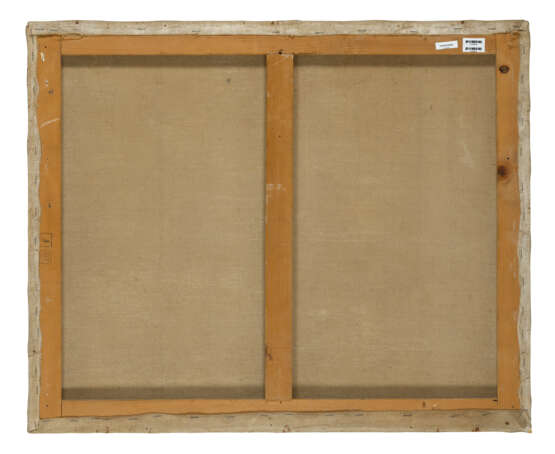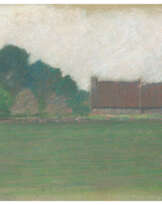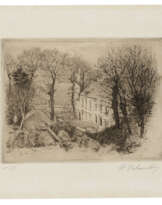ID 1051700
Lot 123 | Henri Delavallée (1862-1943)
Estimate value
€ 140 000 – 180 000
Cour de ferme
signé et daté ‘H Delavallée 87’ (en bas à droite)
huile sur toile
60.2 x 73.2 cm.
Peint en 1887
signed and dated 'H Delavallée 87' (lower right)
oil on canvas
23 ¾ x 29 7⁄8 in.
Painted in 1887
Provenance
Atelier de l’artiste.
Mélanie Rouat, Riec-sur-Belon.
Galerie Jean Chauvelin, Paris.
Sam Josefowitz, Pully (acquis auprès de celle-ci le 21 février 1967).
Puis par descendance aux propriétaires actuels.
Literature
J. Sutter, Les Néo-Impressionnistes, Neuchâtel, 1970, p. 173 (illustré en couleurs).
P.-H. Feist et I. F. Walther, La peinture impressionniste, 1860-1920, Première partie, L'Impressionnisme en France, Bonn, 2002, p. 294 (illustré en couleurs).
Exhibited
New York, The Solomon R. Guggenheim Museum, Neo-Impressionism, février-avril 1968, p. 151, no. 110 (illustré).
Paris, Musée d'Orsay, Le néo-impressionnisme de Seurat à Klee, mars-juillet 2005, p. 162 (illustré en couleurs, p. 163).
Further details
Entraîén par l’un de ses camarade d’atelier en 1881, Henri Delavallée est l’un des premiers à découvrir la côte bretonne, de Ouessant à Châteauneuf-du-Faou, en passant par Pont-Aven. Quelques années plus tard, aux pensions Julia et Gloanec, il rencontre Gauguin, Sérusier et Bernard et s’initie aux techniques de la toute nouvelle école de Pont-Aven.
Cependant, Delavallée ressent rapidement le besoin d’aller chercher ailleurs et de continuer à explorer d’autres champs stylistiques. En 1887, il passe sous l’influence de Georges Seurat et de sa nouvelle technique pointilliste. Influencé également par Camille Pissarro, et installé près de Fontainebleau, à Marlotte, Delavallée exécute entre 1887 et 1890 une série de toiles pointillistes dans lesquelles il exprime sa dextérité et sa maitrise exceptionnelle de cette nouvelle peinture optique. La présente Cour de ferme, peinte en 1887, à la fois réaliste – la forme du puits est typique de la région – et abstraite en est un parfait exemple. Les bâtiments, accolés les uns aux autres comme des volumes géométriques tracés à la règle, ainsi que la frontalité des plans juxtaposés, confèrent à cette vue une dimension irréelle. Usant de touches de différentes largeurs, pour décrire les motifs proches ou lointains, pratiquant la division et le contraste de tons (l’ombre du puits est traitée en une juxtaposition de vert, de l’orange, de rose et de violet) Delavallée transpose, par sa grande technique, un paysage anodin en un spectacle presque onirique.
Cependant, Delavallée ressent rapidement le besoin d’aller chercher ailleurs et de continuer à explorer d’autres champs stylistiques. En 1887, il passe sous l’influence de Georges Seurat et de sa nouvelle technique pointilliste. Influencé également par Camille Pissarro, et installé près de Fontainebleau, à Marlotte, Delavallée exécute entre 1887 et 1890 une série de toiles pointillistes dans lesquelles il exprime sa dextérité et sa maitrise exceptionnelle de cette nouvelle peinture optique. La présente Cour de ferme, peinte en 1887, à la fois réaliste – la forme du puits est typique de la région – et abstraite en est un parfait exemple. Les bâtiments, accolés les uns aux autres comme des volumes géométriques tracés à la règle, ainsi que la frontalité des plans juxtaposés, confèrent à cette vue une dimension irréelle. Usant de touches de différentes largeurs, pour décrire les motifs proches ou lointains, pratiquant la division et le contraste de tons (l’ombre du puits est traitée en une juxtaposition de vert, de l’orange, de rose et de violet) Delavallée transpose, par sa grande technique, un paysage anodin en un spectacle presque onirique.
Que ce soit à Marlotte où à Pont-Aven, lieux entre lesquelles Delavallée partage sa vie, le thème de la cour de ferme est étonnement récurent. «La composition et la technique diffèrent selon les lieux, ce qui permet de distinguer les paysages de Bretagne, où les personnages et le motif, en un assemblage de touches plus ou moins longues et diversement orientées, emplissent l’espace et ne réservent au ciel qu’une place infime […] des tableaux peints à Marlotte et dans sa région, dénués de présence humaine où priment l’ordonnance géométrique et le point.»(D. Lobstein in Le néo-impressionnisme de Seurat à Klee, cat. exp., Musée d'Orsay, Paris, 2005, p. 162 ).
Deux ans plus tard, Delavallée, toujours hanté par le souvenir de Millet, se tourne vers la gravure – grâce à laquelle il rencontrera ses premier succès chez Durand-Ruel. Puis, vers 1891, il s’expatrie en Turquie afin d’explorer une nouvelle lumière et une nouvelle atmosphère. Vers 1900, fort des succès et de la reconnaissance acquise à Constantinople, Henri Delavallée revient en France et notamment à Pont-Aven, se replongeant dans le néo- impressionnisme et la gravure.
Brought there by a fellow painter from his studio in 1881, Henri Delavallée was one of the first artist to discover the Breton coast, from Ouessant to Châteauneuf-du-Faou, along with Pont-Aven. A few years later, at Pension Julia and Pension Gloanec, he met Gauguin, Sérusier, and Bernard, and was introduced to the techniques of the new Pont-Aven school.
Despite these enriching encounters, Delavallée felt the need to search further afield, and continued exploring other stylistic fields. In 1887 he came under the influence of Georges Seurat, with his new pointillist technique. Also influenced by Camille Pissarro, and settling in Marlotte, near Fontainebleau, between 1887 and 1890, Delavallée produced a series of pointillist canvases which express his dexterity and his exceptional mastery of this new optical form of painting. The present Cour de ferme, painted in 1887, is both realistic - the shape of the well is typical of the region - and abstract. The buildings, set against each other like geometric volumes drawn with a ruler, and the frontal aspect of the juxtaposed planes, give this view an unreal dimension. Using brushstrokes of different widths to depict motifs near and far, and using division and contrasting tones (the shadow of the well is treated in a juxtaposition of green, orange, pink and violet), Delavallée's great technique transforms an innocuous landscape into an almost dreamlike spectacle.Both in Marlotte, as well as Pont-Aven, the locations between which Delavallée spent his life, the theme of the farmyard is surprisingly recurrent. “The composition and technique differ according to the location, making it possible to distinguish the landscapes of Brittany, the characters, and the motif, in an assembly where longer or shorter diversely oriented touches fill the space, leaving only a tiny amount of room for the sky […] the paintings produced in Marlotte and the region are absent of human presence, where geometric order and point take precedence.” (D. Lobstein in Le Néo- Impressionnisme de Seurat à Klee, cat. exp., Musée d’Orsay, Paris, 2005, p. 162).
Two years later, Delavallée, still haunted by the memory of the landscapes painted by Millet, turned to engraving, thanks to which he achieved his first success at Durand-Ruel. Then, around 1891, he emigrated to Turkey in order to explore a new light and a new atmosphere. Around 1900, with the success and recognition he had acquired in Constantinople, Henri Delavallée returned to France, notably to Pont-Aven, plunging back into neo-impressionism and engraving.
| Applied technique: | Oil on canvas |
|---|---|
| Auction house category: | Paintings |
| Applied technique: | Oil on canvas |
|---|---|
| Auction house category: | Paintings |
| Address of auction |
CHRISTIE'S 9 Avenue Matignon 75008 Paris France | ||||||||||||||
|---|---|---|---|---|---|---|---|---|---|---|---|---|---|---|---|
| Preview |
| ||||||||||||||
| Phone | +33 (0)1 40 76 85 85 | ||||||||||||||
| Fax | +33 (0)1 40 76 85 86 | ||||||||||||||
| Conditions of purchase | Conditions of purchase | ||||||||||||||
| Shipping |
Postal service Courier service pickup by yourself | ||||||||||||||
| Payment methods |
Wire Transfer | ||||||||||||||
| Business hours | Business hours
|











